Thermophysical Properties of Larch Bark Composite Panels
Abstract
1. Introduction
2. Materials and Methods
2.1. Material
2.2. Methods
- —sample thickness in m,
- —thermal diffusivity of material in m2.s−1.
- q—heat flux density in W.m−2
- l—sample thickness in m
- λ—thermal conductivity of sample in W.m−1.K−1
- t—time in s
- —relaxation time in s
- ierfc—error function
- —material thermal conductivity in W.m−1.K−1,
- —thermal diffusivity of material in m2.s−1,
- —material density in kg.m−3.
3. Results and Discussion
3.1. Thermal Conductivity
3.2. Thermal Diffusivity
3.3. Specific Heat Capacity
3.4. Bark Panels vs. Other Insulation Panels
4. Conclusions
Author Contributions
Funding
Data Availability Statement
Acknowledgments
Conflicts of Interest
References
- EC. European Commission Staff Working Document—Directive (EU) 2018/844 of the European Parliament and the Council of 30 May 2018 Amending Directive 2010/31/EU on the Energy Performance of Buildings and Directive 2012/27/EU on Energy Efficiency; European Commission: Brussels, Belgium, 2018. [Google Scholar]
- EC. European Commission, Energy Strategy. Clean Energy for all Europeans Package; European Union: Brussels, Belgium, 2019. [Google Scholar] [CrossRef]
- CIB. Agenda 21 on Sustainable Construction; Conseil International du Matiment: Rotterdam, The Netherlands, 1999; p. 122. [Google Scholar]
- UNEP. Buidlings and Climate Change: Status, Challenges and Opportunities; United Nations Environment Programme: New York, NY, USA, 2007; p. 87. [Google Scholar]
- Abubakar, M.; Raji, A.; Hassan, M. Comparative study of thermal insulation boards from leaf and bark fibres of camel’s foot (Piliostigma thonningii L.). Niger. J. Technol. 2018, 37, 108. [Google Scholar] [CrossRef]
- Tangjuank, S.; Kumfu, S. Particle Boards from Papyrus Fibers as Thermal Insulation. J. Appl. Sci. 2011, 11, 2640–2645. [Google Scholar] [CrossRef][Green Version]
- Gounni, S.; Mabrouk, M.T.; Wazna, M.E.; Kheiri, A.; Alami, M.E.; Bouari, A.E.; Cherkaoui, O. Thermal and economic evalua-tion of new insulation materials for building envelope based on textile waste. Appl. Therm. Eng. 2019, 149, 475–483. [Google Scholar] [CrossRef]
- Bharadwaj, P.; Jankovic, L. Self-Organised Approach to Designing Building Thermal Insulation. Sustainability 2020, 12, 5764. [Google Scholar] [CrossRef]
- Gaujena, B.; Agapovs, V.; Borodinecs, A.; Strelets, K. Analysis of Thermal Parameters of Hemp Fiber Insulation. Energies 2020, 13, 6385. [Google Scholar] [CrossRef]
- Eurostat, Energy Consumption in Households (EU-28, 2017 Data). 2019. Available online: http://ec.europa.eu/eurostat/statistics-explained/index.php/Energy_consumption_in_households (accessed on 7 June 2021).
- EC/European Commission. ANNEX to the Communication from the Commission to the European Parliament, the Europe—An Council the European Economic and Social Committee and the Committee of the Regions; The European Green Deal; European Commission: Brussels, Belgium, 2019. [Google Scholar]
- Havrysh, V.; Kalinichenko, A.; Brzozowska, A.; Stebila, J. Agricultural Residue Management for Sustainable Power Generation: The Poland Case Study. Appl. Sci. 2021, 11, 5907. [Google Scholar] [CrossRef]
- Havrysh, V.; Kalinichenko, A.; Brzozowska, A.; Stebila, J. Life Cycle Energy Consumption and Carbon Dioxide Emissions of Agricultural Residue Feedstock for Bioenergy. Appl. Sci. 2021, 11, 2009. [Google Scholar] [CrossRef]
- Branowski, B.; Zabłocki, M.; Sydor, M. The Material Indices Method in the Sustainable Engineering Design Process: A Review. Sustainability 2019, 11, 5465. [Google Scholar] [CrossRef]
- Anastaselos, D.; Giama, E.; Papadopoulos, A. An assessment tool for the energy, economic and environmental evaluation of thermal insulation solutions. Energy Build. 2009, 41, 1165–1171. [Google Scholar] [CrossRef]
- EC. European Commission, Circular Economy Action Plan. For a Cleaner and More Competitive Europe; new_circular_economy_action_plan; European Commission: Brussels, Belgium, 2020. [Google Scholar]
- EC. European Commission, Communication from the Commission to the European Parliament, the Council, the European Economic and Social Committee and the Committee of the Regions. Sustainable Europe Investment Plan. European Green Deal Investment Plan; European Commission: Brussels, Belgium, 2020. [Google Scholar]
- U.S. Chamber of Commerce Foundation. Chamber of Commerce Foundation. Achieving a Circular Economy: How the Private Sector is Reimaging the Future of Business; U.S. Chamber of Commerce Foundation: Washington DC, USA, 2015; p. 76. [Google Scholar]
- Cetiner, I.; Shea, A.D. Wood waste as an alternative thermal insulation for buildings. Energy Build. 2018, 168, 374–384. [Google Scholar] [CrossRef]
- Kania, G.; Kwiecień, K.; Malinowski, M.; Gliniak, M. Analyses of the Life Cycles and Social Costs of CO2 Emissions of Single-Family Residential Buildings: A Case Study in Poland. Sustainability 2021, 13, 6164. [Google Scholar] [CrossRef]
- Vanova, R.; Vlcko, M.; Stefko, J. Life Cycle Impact Assessment of Load-Bearing Straw Bale Residential Building. Materials 2021, 14, 3064. [Google Scholar] [CrossRef]
- Mitterpach, J.; Igaz, R.; Štefko, J. Environmental evaluation of alternative wood-based external wall assembly. Acta Fac. Xylol. 2020, 61, 133–149. [Google Scholar]
- Asdrubali, F.; D´Alessandro, F.; Schiavoni, S. A review of unconventional sustainable building insulation materials. Sustain. Mater. Technol. 2015, 4, 1–17. [Google Scholar] [CrossRef]
- Asdrubali, F.; Ferracuti, B.; Lombardi, L.; Guattari, C.; Evangelisti, L.; Grazieschi, G. A review of structural, thermo-physical, acoustical, and environmental properties of wooden materials for building applications. Build. Environ. 2017, 114, 307–332. [Google Scholar] [CrossRef]
- Novák, I.; Krupa, I.; Sedliačik, J.; Žigo, O.; Jurkovič, P.; Matyašovský, J. Investigation into mechanical, surface and adhesive properties of date palm wood-polyolefin micro composites. Acta Fac. Xylol. Zvolen. 2020, 62, 27–34. [Google Scholar]
- Fiorelli, J.; Ramos, R.D.; Sayama, J.T.; Barrero, N.G.; Palone, E.D.J.A. Particleboards with waste wood from reforestation. Acta Sci. Technol. 2014, 36, 251. [Google Scholar] [CrossRef]
- Bekhta, P.; Sedliačik, J.; Kačík, F.; Noshchenko, G.; Kleinoví, A. Lignocellulosic waste fibers and their application as a component of urea-formaldehyde adhesive composition in the manufacture of plywood. Eur. J. Wood Wood Prod. 2019, 77, 495–508. [Google Scholar] [CrossRef]
- Souza, A.M.; Nascimento, M.F.; Almeida, D.H.; Silva, D.; Almeida, T.H.; Christoforo, A.L.; Lahr, F.A. Wood-based composite made of wood waste and epoxy based ink-waste as adhesive: A cleaner production alternative. J. Clean. Prod. 2018, 193, 549–562. [Google Scholar] [CrossRef]
- Antov, P.; Mantanis, G.I.; Savov, V. Development of Wood Composites from Recycled Fibres Bonded with Magnesium Lignosulfonate. Forests 2020, 11, 613. [Google Scholar] [CrossRef]
- Savov, V.; Antov, P. Engineering the Properties of Eco-Friendly Medium Density Fibreboards Bonded with Lignosulfonate Adhesive. Drv. Ind. 2020, 71, 157–162. [Google Scholar] [CrossRef]
- Antov, P.; Krišt’ák, L.; Réh, R.; Savov, V.; Papadopoulos, A.N. Eco-Friendly Fiberboard Panels from Recycled Fibers Bonded with Calcium Lignosulfonate. Polymers 2021, 13, 639. [Google Scholar] [CrossRef] [PubMed]
- Madurwar, M.V.; Ralegaonkar, R.V.; Mandavgane, S.A. Application of agro-waste for sustainable construction materials: A review. Constr. Build. Mater. 2013, 38, 872–878. [Google Scholar] [CrossRef]
- Barbu, M.C.; Réh, R.; Çavdar, A.D. Non-wood lignocellulosic composites. Chapter 8. In Research Developments in Wood Engineering and Technology; Aguilera, J.A., Davim, P., Eds.; IGI Global: Hershey, PA, USA, 2014; pp. 281–319. [Google Scholar]
- Santos, M.F.N.; Battistelle, R.A.G.; Bezerra, B.S.; Varum, H.S.A. Comparative study of the life cycle assessment of particleboards made of residues from sugarcane bagasse (saccharum spp.) and pine wood shavings (Pinus elliottii). J. Clean. Prod. 2014, 64, 345–355. [Google Scholar] [CrossRef]
- Dukarska, D.; Pędzik, M.; Rogozińska, W.; Rogoziński, T.; Czarnecki, R. Characteristics of straw particles of selected grain species purposed for the production of lignocellulose particleboards. Part. Sci. Technol. 2021, 39, 213–222. [Google Scholar] [CrossRef]
- Fiorelli, J.; Galo, R.G.; Castro, S.L., Jr.; Belini, U.L.; Lasso, P.R.O.; Savastano, H., Jr. Multilayer particleboard produced with agroindustrial waste and amazonian vegetable fibres. Waste Biomass 2017, 8, 1–11. [Google Scholar]
- Eschenhagen, A.; Raj, M.; Rodrigo, N.; Zamora, A.; Labonne, I.; Evon, P.; Walemane, H. Investigation of miscanthus and sun-flower stalk fiber-reinforced composites for insulation applications. Adv. Civ. Eng. 2019, 2019, 9328087. [Google Scholar]
- Guna, V.; Ilangovan, M.; Hu, C.; Venkatesh, K.; Reddy, N. Valorization of sugarcane bagasse by developing completely biodegradable composites for industrial applications. Ind. Crop. Prod. 2019, 131, 25–31. [Google Scholar] [CrossRef]
- Busquets-Ferrer, M.; Czabany, I.; Vay, O.; Gindl-Altmutter, W.; Hansmann, C. Alkali-extracted tree bark for efficient bio-based thermal insulation. Constr. Build. Mater. 2021, 271, 121577. [Google Scholar] [CrossRef]
- Xing, C.; Zhang, S.Y.; Deng, J.; Wang, S. Investigation of the effects of bark fiber as core material and its resin content on three-layer MDF performance by response surface methodology. Wood Sci. Technol. 2007, 41, 585–595. [Google Scholar] [CrossRef]
- Kain, G.; Tudor, E.M.; Barbu, M.-C. Bark Thermal Insulation Panels: An Explorative Study on the Effects of Bark Species. Polymers 2020, 12, 2140. [Google Scholar] [CrossRef]
- Miles, P.D.; Smith, W.B. Specific Gravity and Other Properties of Wood and Bark for 156 Tree Species Found in North America; USDA Forest Service: Madison, WI, USA, 2009; Volume 38, pp. 1–35.
- Pereira, H. The Rationale behind Cork Properties: A Review of Structure and Chemistry. Bioresources 2015, 10, 6207–6229. [Google Scholar] [CrossRef]
- Nemli, G.; Gezer, E.; Yıldız, S.; Temiz, A.; Aydın, A. Evaluation of the mechanical, physical properties and decay resistance of particleboard made from particles impregnated with Pinus brutia bark extractives. Bioresour. Technol. 2006, 97, 2059–2064. [Google Scholar] [CrossRef]
- Kain, G.; Lienbacher, B.; Barbu, M.-C.; Richter, K.; Petutschnigg, A. Larch (Larix decidua) bark insulation board: Interactions of particle orientation, physical–mechanical and thermal properties. Holz Roh Werkst. 2018, 76, 489–498. [Google Scholar] [CrossRef]
- Fengel, D.; Wegener, G. Wood: Chemistry, Ultrastructure, Reactions; Kessel Verlag: Remagen, Germany, 2003; p. 613. [Google Scholar]
- Rowell, R. Handbook of Wood Cchemistry and Wood Composites, 2nd ed.; CRC Press: Boca Raton, FL, USA, 2012. [Google Scholar]
- Barbu, M.C.; Lohninger, Y.; Hofmann, S.; Kain, G.; Petutschnigg, A.; Tudor, E.M. Larch Bark as a Formaldehyde Scavenger in Thermal Insulation Panels. Polymers 2020, 12, 2632. [Google Scholar] [CrossRef]
- Tudor, E.M.; Barbu, M.C.; Petutschnigg, A.; Réh, R.; Krišťák, Ľ. Analysis of Larch-Bark Capacity for Formaldehyde Removal in Wood Adhesives. Int. J. Environ. Res. Public Health 2020, 17, 764. [Google Scholar] [CrossRef] [PubMed]
- Krišťák, Ľ.; Igaz, R.; Ružiak, I. Applying the EDPS Method to the Research into Thermophysical Properties of Solid Wood of Coniferous Trees. Adv. Mater. Sci. Eng. 2019, 2019, 1–9. [Google Scholar] [CrossRef]
- Igaz, R.; Krišťák, Ľ.; Ružiak, I.; Gajtanska, M.; Kučerka, M. Thermophysical Properties of OSB Boards versus Equilibrium Moisture Content. Bioresources 2017, 12, 8106–8118. [Google Scholar]
- Suleiman, B.M.; Larfeldt, J.; Leckner, B.; Gustavsson, M. Thermal conductivity and diffusivity of wood. Wood Sci. Technol. 1999, 33, 465–473. [Google Scholar] [CrossRef]
- Kain, G.; Tudor, E.M.; Dettendorfer, A.; Barbu, M.C. Potenzial von Baumrinde fur den Einsatz als Schallabsorptionsmaterial. Bauphysic 2020, 42, 124–130. [Google Scholar] [CrossRef]
- Gibson, L.J.; Ashby, M.F. Cellular Solids: Structure and Properties; Cambridge University Press: Cambridge, UK, 1999. [Google Scholar]
- Kain, G.; Barbu, M.-C.; Teischinger, A.; Musso, M.; Petutschnigg, A. Substantial Bark Use as Insulation Material. For. Prod. J. 2012, 62, 480–487. [Google Scholar] [CrossRef]
- Kain, G.; Guttler, V.; Barbu, M.C.; Petutschnigg, A.; Richter, K.; Tondi, G. Density related properties of bark insulation boards bonded with tannin hexamine resin. Eur. J. Wood Prod. 2014, 72, 417–424. [Google Scholar] [CrossRef]
- Sonderegger, W.; Niemz, P. Thermal and moisture flux in soft fibreboards. Holz Roh Werkst. 2012, 70, 25–35. [Google Scholar] [CrossRef]
- Gößwald, J.; Barbu, M.-C.; Petutschnigg, A.; Tudor, E. Binderless Thermal Insulation Panels Made of Spruce Bark Fibres. Polymers 2021, 13, 1799. [Google Scholar] [CrossRef]
- Brombacher, V.; Michel, F.; Niemz, P.; Volkmer, T. Untersuchungen zu Warmeleitfahigkeit und Feuchteverhalten von Holzfaserplatten und Materialkombinationen. Bauphysic 2012, 34, 157–169. [Google Scholar] [CrossRef]
- Haupl, P. Bauphysik; Ernst and Sohn: Berlin, Germany, 2008; p. 66. [Google Scholar]
- Schunk, C.; Treml, S.; Troger, F. Lose Dammstoffe aus Holz—Warmeleitfahighkeit von speziell hergestellten Frassspanen ausgewahlter Holzarten. Eur. J. Wood Prod. 2009, 67, 487–488. [Google Scholar] [CrossRef]
- Danihelova, A.; Nemec, M.; Gergel, T.; Gejdos, M.; Gordanova, J.; Scesny, P. Usage of Recycled Technical Textiles as Thermal Insulation and an Acoustic Absorber. Sustainability 2019, 11, 2968. [Google Scholar] [CrossRef]
- Grohe, B. Heat conductivities of insulation mats based on water glass bonded non-textile hemp or flax fibers. Holz Roh Werkstoff 2004, 62, 352–357. [Google Scholar] [CrossRef]
- Rebolledo, P.; Clutier, A.; Yemele, M.C. Effect of Density and Fiber Size on Porosity and Thermal Conductivity of Fiber-board Mats. Fibers 2018, 6, 81. [Google Scholar] [CrossRef]
- Bertolini, M.d.S.; de Morais, A.G.; Christoforo, A.L.; Bertoli, S.R.; dos Santos, W.N.; Lahr, F.A.R. Acoustic absorption and thermal insulation of wood panels: Influence of porosity. Bioresources 2019, 14, 3746–3757. [Google Scholar]
- Carson, J.K.; Lovatt, S.; Tanner, D.J.; Cleland, A.C. Thermal conductivity bounds for isotropic, porous materials. Int. J. Heat Mass Transf. 2005, 48, 2150–2158. [Google Scholar] [CrossRef]
- Kain, G.; Guttler, V.; Lienbacher, B.; Barbu, M.C.; Petutschnigg, A.; Richter, K. Effects of different flavonoid extracts in optimizing tanninglued bark insulation boards. Wood Fiber. Sci. 2015, 47, 258–269. [Google Scholar]
- Kain, G.; Lienbacher, B.; Barbu, M.-C.; Plank, B.; Richter, K.; Petutschnigg, A. Evaluation of relationships between particle orientation and thermal conductivity in bark insulation board by means of CT and discrete modeling. Case Stud. Nondestruct. Test. Eval. 2016, 6, 21–29. [Google Scholar] [CrossRef]
- Sonderegger, W.; Niemz, P. Thermal conductivity and water vapour transmission properties of wood-based materials. Holz Roh Werkst. 2009, 67, 313–321. [Google Scholar] [CrossRef]
- Joščák, M.; Sonderegger, W.; Niemy PSchnider, T.; Oppikofer, R.; Lammar, L. Influence of the air cavities on thermal conductivity of selected wood-based materials and their application for building industry. Bauphysik 2012, 34, 32–37. [Google Scholar] [CrossRef]
- Gupta, G.; Yan, N.; Feng, M.W. Effect of pressing temperature and particle size on bark board properties made from beetle-infested lodgepole pine (Pinus contorta) barks. Forest Prod. J. 2011, 61, 478–488. [Google Scholar] [CrossRef]
- Mahlia, T.M.I.; Taufiq, B.N.; Ismail Masjuki, H.H. Correlation between thermal conductivity and the thickness of selected in-sulation materials for building wall. Energy Build. 2007, 39, 182–187. [Google Scholar] [CrossRef]
- Pásztory, Z.; Mohácsiné, I.R.; Börcsök, Z. Investigation of thermal insulation panels made of black locust tree bark. Constr. Build. Mater. 2017, 147, 733–735. [Google Scholar] [CrossRef]
- Reifsnyder, W.E.; Herrington, L.P. Thermophysical Properties of Bark of Shortleaf, Longleaf and Red Pine; Yale School of Forestry & Environmental Studies Bulletin Series; Yale School of Forestry: New Haven, CT, USA, 1967; Volume 80. [Google Scholar]
- Kawasaki, T.; Kawai, S. Thermal insulation properties of wood-based sandwich panel for use as structural insulated walls and floors. J. Wood Sci. 2006, 52, 75–83. [Google Scholar] [CrossRef]
- Harada, T.; Hata, T.; Ishihara, S. Thermal constants of wood during the heating process measured with the laser flash method. J. Wood Sci. 1998, 44, 425–431. [Google Scholar] [CrossRef]
- Rargland, K.W.; Aerts, D.J.; Baker, A.J. Properties of Wood for Comustion Analysis. Bioresour. Technol. 1991, 37, 161–168. [Google Scholar] [CrossRef]
- Simpson, W.; Wolde, A.T. Physical properties and moisture relations of wood. In Wood Handbook: Wood as an Engineering Material; USDA Forest Service: Madison, WI, USA, 1999. [Google Scholar]
- Koljo, B. Something about the heat phenomena of woods and trees. Forstwiss. Cent. 1950, 69, 538–551. [Google Scholar] [CrossRef]
- Gupta, M.; Yang, J.; Roy, C. Specific heat and thermal conductivity of softwood bark and softwood char particles☆. Fuel 2003, 82, 919–927. [Google Scholar] [CrossRef]
- Koch, P. Specific Heat of Ovendry Spruce Pine Wood and Bark. Wood Sci. 1969, 1, 203–214. [Google Scholar]
- Aditya, L.; Mahlia, T.M.I.; Rismanchi, B.; Ng, H.; Hasan, M.; Metselaar, H.S.C.; Muraza, O.; Aditiya, H. A review on insulation materials for energy conservation in buildings. Renew. Sustain. Energy Rev. 2017, 73, 1352–1365. [Google Scholar] [CrossRef]
- Sari, N.H.; Wardana, I.N.G.; Irawan, Y.S.; Siswanto, E.P. Physical and Acoustical Properties of Corn Husk Fiber Panels. Adv. Acoust. Vib. 2016, 2016, 5971814. [Google Scholar] [CrossRef]
- Saha, P.; Manna, S.; Chowdhury, R.; Sen, R.; Roy, D.; Adhikari, B. Enhancement of tensile strength of lignocellulosic jute fibers by alkali-steam treatment. Bioresour. Technol. 2010, 101, 3182–3187. [Google Scholar] [CrossRef]
- Salit, M.S. Tropical Natural Fibres and Their Properties. In Tropical Natural Fibre Composites. Engineering Materials; Springer: Singapore, 2014; pp. 15–38. [Google Scholar]
- Papadopoulos, A. State of the art in thermal insulation materials and aims for future developments. Energy Build. 2005, 37, 77–86. [Google Scholar] [CrossRef]
- Taghiyari, H.; Militz, H.; Antov, P.; Papadopoulos, A. Effects of Wollastonite on Fire Properties of Particleboard Made from Wood and Chicken Feather Fibers. Coatings 2021, 11, 518. [Google Scholar] [CrossRef]
- Aristri, M.; Lubis, M.; Yadav, S.; Antov, P.; Papadopoulos, A.; Pizzi, A.; Fatriasari, W.; Ismayati, M.; Iswanto, A. Recent Developments in Lignin- and Tannin-Based Non-Isocyanate Polyurethane Resins for Wood Adhesives—A Review. Appl. Sci. 2021, 11, 4242. [Google Scholar] [CrossRef]
- Papadopoulos, A. Advances in Wood Composites III. Polymers 2021, 13, 163. [Google Scholar] [CrossRef]
- Osvaldova, L.M.; Markova, I.; Jochim, S.; Bares, J. Experimental Study of Straw-Based Eco-Panel Using a Small Ignition Initiator. Polymers 2021, 13, 1344. [Google Scholar] [CrossRef] [PubMed]
- Tudor, E.M.; Scheriau, C.; Barbu, M.C.; Réh, R.; Krišťák, Ľ.; Schnabel, T. Enhanced Resistance to Fire of the Bark-Based Panels Bonded with Clay. Appl. Sci. 2020, 10, 5594. [Google Scholar] [CrossRef]
- Tudor, E.M.; Dettendorfer, A.; Kain, G.; Barbu, M.C.; Réh, R.; Krišťák, Ľ. Sound-Absorption Coefficient of Bark-Based Insulation Panels. Polymers 2020, 12, 1012. [Google Scholar] [CrossRef]
- Tudor, E.; Kristak, L.; Barbu, M.; Gergeľ, T.; Němec, M.; Kain, G.; Réh, R. Acoustic Properties of Larch Bark Panels. Forests 2021, 12, 887. [Google Scholar] [CrossRef]
- Réh, R.; Igaz, R.; Krišťák, Ľ.; Ružiak, I.; Gajtanska, M.; Božíková, M.; Kučerka, M. Functionality of Beech Bark in Adhesive Mixtures Used in Plywood and Its Effect on the Stability Associated with Material Systems. Materials 2019, 12, 1298. [Google Scholar] [CrossRef]
- Tudor, E.M.; Zwickl Ch Eichinger Ch Petutschnigg, A.; Barbu, M.C. Performance of softwood bark comminution technologies for determination of targeted particle size in further upcycling applications. J. Cleaner Prod. 2020, 269, 122412. [Google Scholar] [CrossRef]
- Réh, R.; Krišťák, Ľ.; Sedliačik, J.; Bekhta, P.; Božiková, M.; Kunecová, D.; Vozárová, V.; Tudor, E.; Antov, P.; Savov, V. Utilization of Birch Bark as an Eco-Friendly Filler in Urea-Formaldehyde Adhesives for Plywood Manufacturing. Polymers 2021, 13, 511. [Google Scholar] [CrossRef]
- Pfundsteing, M.R.; Gellert, M.; Spitzner, H.; Rudolphi, A. Insulation Materials: Basics, Materials, Applications; Department for International Architecture Documentation Corporation: Munich, Germany, 2007. [Google Scholar]
- Moresova, M.; Sedliacikova, M.; Stefko, J.; Bencikova, D. Perception of wooden houses in the Slovak Republic. Acta Fac. Xylol. Zvolen 2019, 61, 121–135. [Google Scholar]
- Potkány, M.; Gejdoš, M.; Debnár, M. Sustainable Innovation Approach for Wood Quality Evaluation in Green Business. Sustainability 2018, 10, 2984. [Google Scholar] [CrossRef]
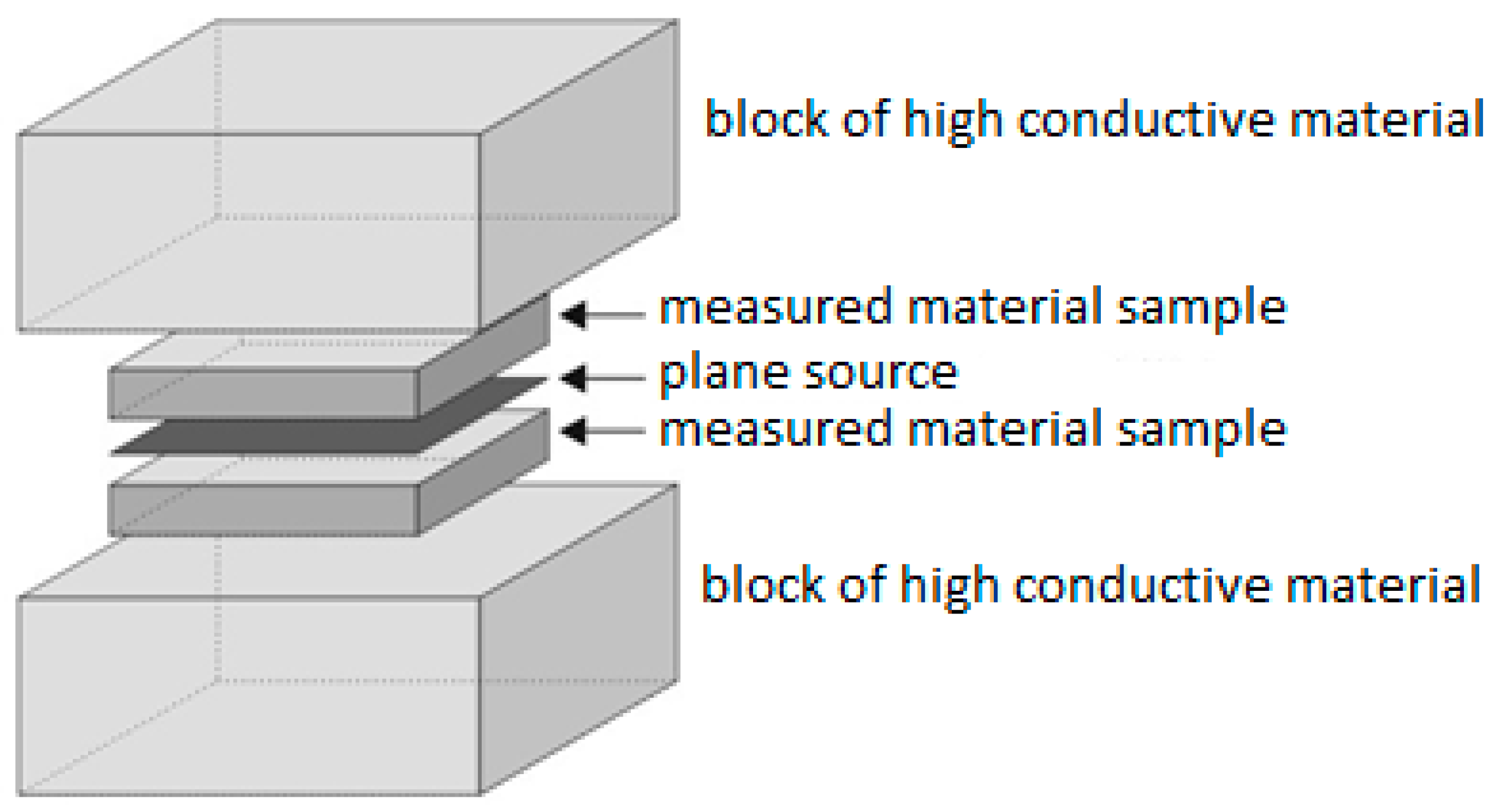

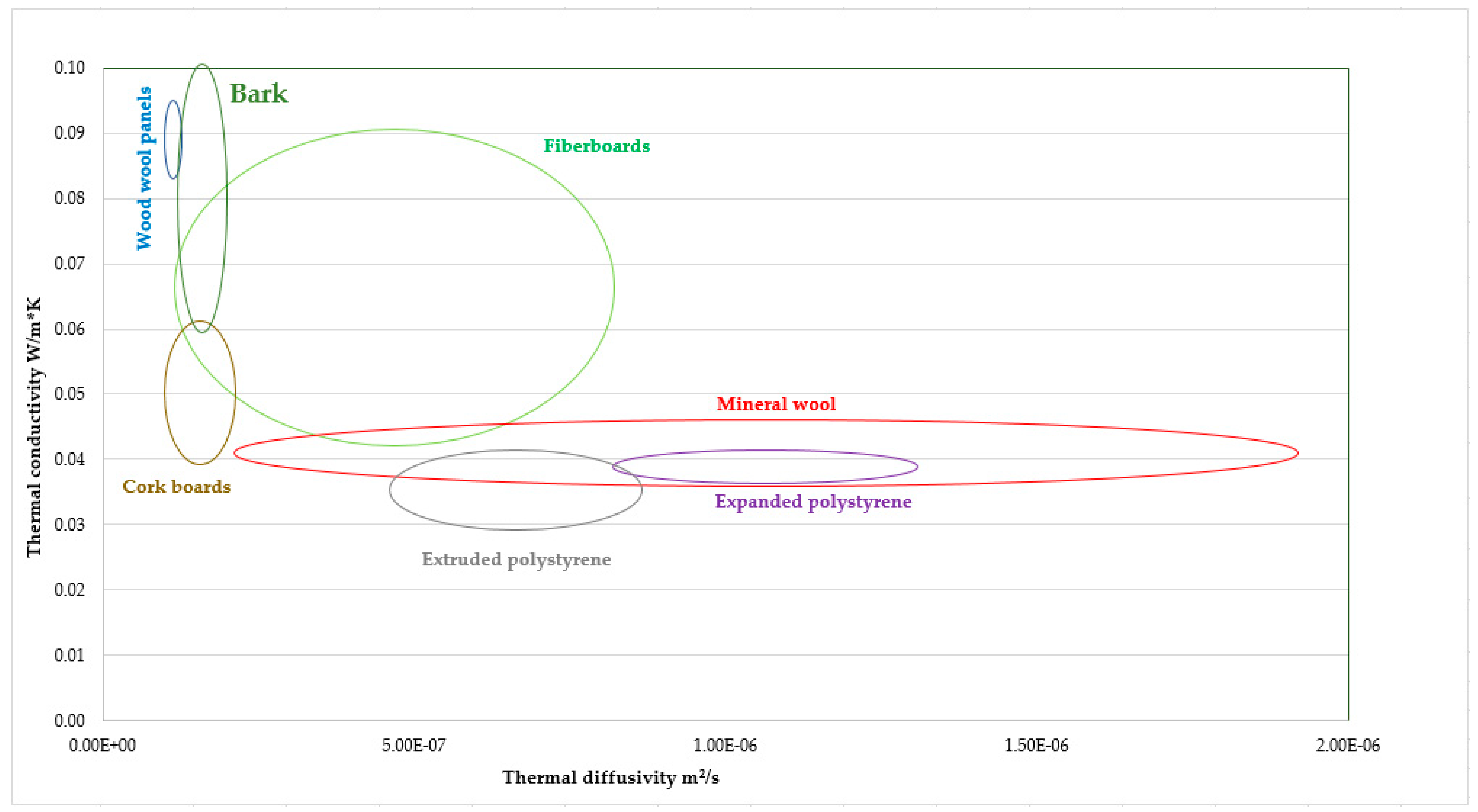
| Material | 1 | 2 | 3 | 4 |
| Image | 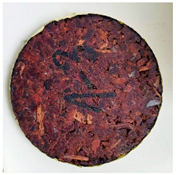 | 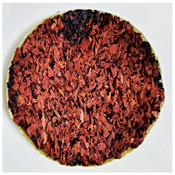 | 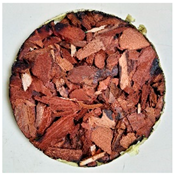 | 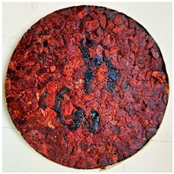 |
| Density [kg.m−3] | ||||
| Resination factor [%] | 10 | 10 | 10 | 10 |
| Particle size [mm] | 4–11 | 4–11 | 10–30 | 4–11 |
| Particle orientation | parallel | perpendicular | parallel | parallel |
| Material | 5 | 6 | 7 | 8 |
| Image | 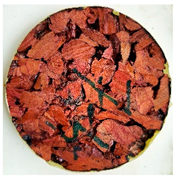 | 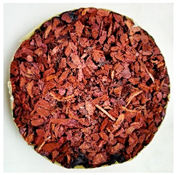 | 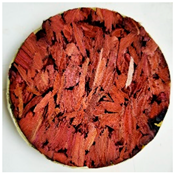 | 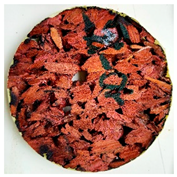 |
| Density [kg.m−3] | ||||
| Resination factor [%] | 20 | 10 | 10 | 20 |
| Particle size [mm] | 10–30 | 4–11 | 10–30 | 10–30 |
| Particle orientation | parallel | parallel | perpendicular | perpendicular |
| Sample | Glue Amount (%) | Density (kg.m−3) | Particle Size (mm) | Thermal Conductivity (W.m−1.K−1) | Specific Heat Capacity (J.kg−1.K−1) | Thermal Diffusivity (mm2.s−1) |
|---|---|---|---|---|---|---|
| 1 | 10 | 688 | 4 to 11 | 0.107 | 1400 | 0.111 |
| 3 | 10 | 477 | 10 to 30 | 0.067 | 1392 | 0.101 |
| 4 | 10 | 537 | 4 to 11 | 0.071 | 1321 | 0.100 |
| 5 | 20 | 369 | 10 to 30 | 0.071 | 1380 | 0.139 |
| 6 | 10 | 362 | 4 to 11 | 0.065 | 1395 | 0.129 |
| Sample | Glue Amount (%) | Density (kg.m−3) | Particle Size (mm) | Thermal Conductivity (W.m−1.K−1) | Specific Heat Capacity (J.kg−1.K−1) | Thermal Diffusivity (mm2.s−1) |
|---|---|---|---|---|---|---|
| 2 | 10 | 345 | 4 to 11 | 0.078 | 1373 | 0.165 |
| 7 | 10 | 471 | 10 to 30 | 0.104 | 1382 | 0.160 |
| 8 | 20 | 355 | 10 to 30 | 0.081 | 1418 | 0.161 |
| Sensitivity of TC on | Parallel Direction | Perpendicular Direction |
|---|---|---|
| Density (kg.m−3) | 90.4% | 74.6% |
| Particle size (mm) | 9.6% | 25.4% |
| Sensitivity of a on | Parallel Direction | Perpendicular Direction |
|---|---|---|
| Density (kg.m−3) | 89.9% | 80.7% |
| Particle size (mm) | 10.1% | 19.3% |
Publisher’s Note: MDPI stays neutral with regard to jurisdictional claims in published maps and institutional affiliations. |
© 2021 by the authors. Licensee MDPI, Basel, Switzerland. This article is an open access article distributed under the terms and conditions of the Creative Commons Attribution (CC BY) license (https://creativecommons.org/licenses/by/4.0/).
Share and Cite
Kristak, L.; Ruziak, I.; Tudor, E.M.; Barbu, M.C.; Kain, G.; Reh, R. Thermophysical Properties of Larch Bark Composite Panels. Polymers 2021, 13, 2287. https://doi.org/10.3390/polym13142287
Kristak L, Ruziak I, Tudor EM, Barbu MC, Kain G, Reh R. Thermophysical Properties of Larch Bark Composite Panels. Polymers. 2021; 13(14):2287. https://doi.org/10.3390/polym13142287
Chicago/Turabian StyleKristak, Lubos, Ivan Ruziak, Eugenia Mariana Tudor, Marius Cătălin Barbu, Günther Kain, and Roman Reh. 2021. "Thermophysical Properties of Larch Bark Composite Panels" Polymers 13, no. 14: 2287. https://doi.org/10.3390/polym13142287
APA StyleKristak, L., Ruziak, I., Tudor, E. M., Barbu, M. C., Kain, G., & Reh, R. (2021). Thermophysical Properties of Larch Bark Composite Panels. Polymers, 13(14), 2287. https://doi.org/10.3390/polym13142287







